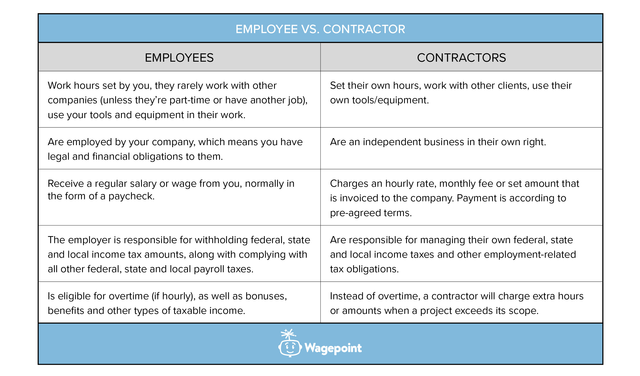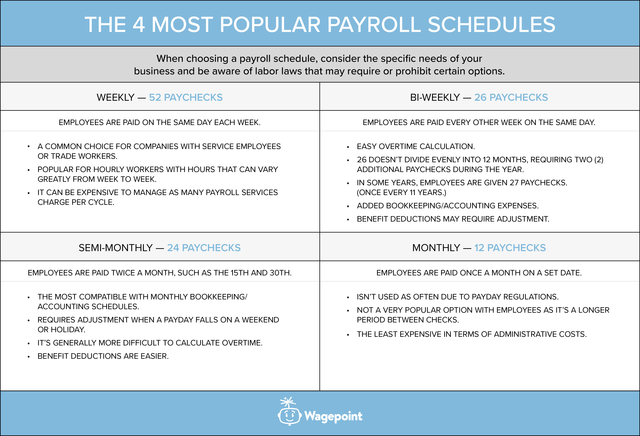In business, there's always a right way and wrong way to get things done. The same is true of small business payroll, regardless of whether you're paying one person or an entire team. Here are some of the basic questions you should ask and answer to get your payroll right.
10 questions to ask about small business payroll
Why does it matter if I make mistakes with my payroll?
Getting things right will save you time and money. A common term you'll hear is payroll compliance - this just means that you are following all the rules. With the IRS punishing one-third of all business owners for payroll errors, getting it wrong could cost you dearly in terms of fines and the time investment needed to undo your mistakes.
Are the people you're paying employees or contractors?
The main differences between employees and contractors are the employer's responsibilities when it comes to paying them.
If someone's a contractor, a professional service provider performing a specific task for a set amount of time at a pre-determined rate of pay, you don't have to do much other than write a check once you receive their invoice.
If you're paying an employee, the picture changes. As an employer, you have to withhold (take out the right amount) of federal, state and possibly even local income tax.
You have to withhold the employee portion of Medicare and social security (FICA taxes) while contributing the required employer portions. Federal and state unemployment taxes (FUTA and SUTA) are paid in full by the employer. There may also be other state and local payroll tax (employment tax) regulations. Fun, right?
If you make a mistake, like paying an employee as a contractor without allowing for income tax and payroll taxes, you could be liable for all of these back taxes. Plus, there's all the accounting and bookkeeping needed to bring your records back up to speed.
Managing income tax withholding and employer taxes is when small business payroll software, like Wagepoint, is worth its weight in gold by automating the calculation, withholding and payment of these items and taking a world of worry off your mind.

Are you paying hourly wages or salaries?
The differences between hourly and salaried workers also affect your payroll. With hourly employees, you have to account for time tracking (the accurate reporting of hours), which can mean paper timesheets or using time-tracking apps.
Hourly employees (non-exempt workers) are also subject to the Fair Labor Standards Act (FLSA) that sets the federal minimum wage and overtime rules, which are $7.25 per hour and time and a half after 40 hours.
Yet, many states also have minimum wage and overtime laws. If your state has a higher minimum wage and differing overtime rules, you must follow those rules in that state.
Salaried employees (exempt workers) are paid set amount per year. This is then broken down over pay periods, such as twice a month (semi-monthly) or every two weeks (bi-weekly). Salaried employees who make more than $23,600 are not subject to overtime or minimum wage laws.
Depending on how your business is structured, you may have a mix of both hourly and salaried workers. The paychecks for your hourly workers will be calculated based on the number of hours worked while salaried workers will receive a set amount each time.
Benefits administration, like healthcare, can also be impacted by pay structure. But that's an entirely different conversation and possibly a future post.
How often are you paying your employees?
The most common types of payroll schedules are weekly, bi-weekly, bi-monthly and monthly. Choosing your payroll frequency is more than a matter of preference. Other factors to be considered include whether or not you have more hourly than salaried workers (or vice versa), the payday requirements in each state, your accounting practices and even the payroll tools you use.

Do you have all of your employer identification numbers?
Your business identification (ID) numbers are your digital fingerprint in your transactions with the IRS and other entities. Basically, your ID numbers tell these agencies who you are. In order to run payroll, you’ll need a federal employer identification number (FEIN or EIN) along with identification numbers for all the state and local labor and revenue agencies to which you are accountable.
Tip: When you create your business IDs, be consistent in how you spell your company name along with the main address you provide. These agencies love consistency and you'll learn to love it too. Also, keep track of these numbers with both digital and paper records. If you want to get fancy, you can even back them up to the cloud.
Have you met all your basic employer and employee responsibilities?
Checklist alert! This list is like making sure you've packed your toothbrush and some clean undies before heading off on a trip. Here's what you need:
- Accurate employee information, including:
- Form W-4 (Form W-9 for contractors)
- A valid Social Security Number (SSN)
- Proof that the employee has the right to work in the United States (Form I-9)
- Voided personal check if the employee is requesting direct deposit
- Correct names, addresses and filing statuses
- Withholding and deposit amounts calculated for:
- Federal income tax
- Medicare and social security
- Federal unemployment tax
- State income tax
- State unemployment tax
- Workers’ compensation
- Disability
Do you have a business banking account with adequate funds?
Having a separate business account is a financial best practice (It's one of the first things any accountant will tell you to do). You will also need to ensure that you have enough funds in this account to run your payroll each time.
If you're using payroll software, you will need to have these funds available several days in advance. If you're doing your own payroll manually, you'll need to ensure that your account is structured to allow for multiple checks, direct deposit and other payroll functions.
Above all, you'll want to make sure your employees are paid on time because it's simply the right thing to do. The fact that you're reading this article shows that you care about checking all the right boxes.
Are you meeting all your reporting requirements?
Just when you thought it was safe to go back in the water, you find out there are also payroll reporting requirements, including:
- Reporting all new hires or rehires to the relevant state within 20 days.
- Payroll tax (employer tax) reporting — federal, state and local.
- Providing W-2s to employees (1099-MISCs to contractors) by Jan 31 each year.
- Pay Stubs — A majority of states require that you provide access to some form of payment details and keep accurate records.
Do you know where to find help?
Even as you read this post, you've likely come up with a list of questions to answer or topics to research further. Here's where you can look:
- Small Business Administration (SBA)
- American Payroll Association (APA)
- IRS Small Business and Self-Employed Tax Center
- Accountants and bookkeepers specializing in small business — if they don't have the answers, they'll know where to find them
- Small business payroll blogs - Some of these are written by software and service providers, but access to the posts is cost- and commitment-free. Simply search terms like "small business payroll" or "small business payroll blogs"
Should you consider automating your small business payroll?
You work, you get paid. It's such a simple concept, but the process is so complex.
In the end, it all comes down to time and resources. Do you want to spend hours on wage tables or would you instead focus on growing your business? Payroll automation can set you free - but you have to ask the right questions to find the right partner.

















